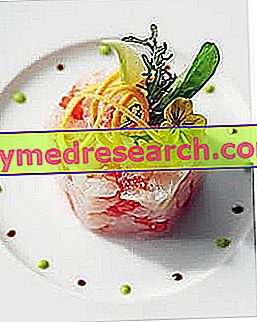Raw fish
Raw fish represents a "slice" (forgive the pun) of the traditional food culture, identifiable in every region or coastal-maritime locality of the globe.
Until a few decades ago, in Italy the term "raw fish" meant above all the recipes based on marinated products, such as anchovies (or anchovies) with flagship or citrus fruits, oysters and lemon mussels, etc. and sea urchin eggs.

We also recall that, in addition to "commercial" catering preparations, there are less widespread but still noteworthy habits that involve the consumption of animals taken and eaten directly in the marine environment. Among these, the most common are undoubtedly: bivalve molluscs (mussels, clams, oysters, and fasolari), gastropod molluscs (limpets, sea ears), sea urchin eggs, and a few other creatures (crustaceans and fish ).
Health risks
Frequently feeding on raw fish (where by fish we mean ALL fishery products) the chances of contracting some diseases are increased; it is an extremely vast subject that includes notions of veterinary medicine, microbiology, marine biology, food hygiene etc., however, we will try to propose a general "simple" but sufficiently comprehensive picture.
Among the diseases related to the consumption of raw fish, the most important are:
- Parasitoses, due to the intake of food contaminated by pathogenic organisms (protozoa, larvae, amoebas etc.)
- Infections due to intake of food contaminated by pathogenic microorganisms (bacteria and viruses)
- Intoxications due to intake of food contaminated ONLY with bacterial toxins or algae
- The toxinfections due to the intake of food contaminated with pathogenic bacteria and their respective toxins
The tendency of bivalve molluscs (which feed on filtering water) is known to retain some pathogenic organisms and microorganisms, which, if not carefully neutralized through cooking, can cause serious and even fatal diseases. The best known are undoubtedly:
- Viral hepatitis: systemic-hepatic disease determined ESPECIALLY by the HAV virus
- Salmonella Typhi and Paratiphi food infection: responsible for typhoid fever and salmonellosis.
- Cholera infection : tendentially epidemic pathology originated by Vibrio Colerae; once frequently widespread in southern Italy
- Fecal coliform infection: determined by Escherichia Coli
- Vibrio Parahaemoliticus toxinfection, which particularly affects Japan
However, discussing the hygiene of raw fish consumption inevitably ends up talking mainly about PARASITOSIS. In this regard, even in Italy - where, in addition to the very recent sushi, it is now tradition to consume marinated, carpaccio and fish tartar (swordfish, tuna, amberjack, bonito, anchovies etc.) - the diagnoses of intestinal parasitosis by ANISAKIS are beginning to increase ( anisakiadee). Especially in Liguria, the consumption of "marinated anchovies with lemon" has caused a significant increase in the occurrence of anisakiasis.
In order to prevent the spread of this pathogen, in 1997 a series of laws was issued in the food industry and in the catering industry. On the basis of this regulation, the sale of food and the supply of raw fish SE is NOT FORBIDDEN. It is NOT previously thrown down at temperatures of -20 ° C for at least 24 hours. It is known that anisakis is an organism present in larval form only in fish (especially in the blue one), in which it occupies exclusively the inner portion of the intestinal lumen. On the contrary, in mammals (marine and not) the larvae progress and develop, significantly altering their metabolism and pathogenicity.
At this point a question arises: if the anisakis is present ONLY in the bowels of the fish ... of which obviously the final consumer does not feed ... how is it possible to contract anisakiasis?
The answer is very simple: although the anisakis is not able to pierce the intestines of fish that are still alive, from the moment of their death (and the relative collapse of the immune barriers) the parasite acquires the ability to migrate inside the tissues animal muscles. It follows that, for personal consumption, having the certainty of eviscerating the fish immediately after capture, it is possible to consume it raw without running the risk of contracting anisakiasis.
However, immediate evisceration does NOT reduce contamination related to other forms of parasitosis, including difillobotriasis and infestation with Clonorchiasis (Opistorchiasi) sinensis.
In the difillobotriasis the pathogenic organism is Diphillobothrium Latu, also commonly called the "tenia" of the fish. Man is infected exclusively by feeding on plerocercoid larvae (therefore evolved) contained in the flesh of sick fish such as salmon; what leaves you speechless is that: for every man infected by Diphillobothrium Latu, up to 1, 000, 000 eggs are expelled with the faeces ... which will subsequently infest small crustaceans of the river courses, exponentially renewing their reproductive / evolutionary cycle.
Clonorchiasis disease (Opistorchiasi) sinensis is caused by a flat worm that can infest mammals' blood, lungs and liver. It, like most parasites, is characterized by different and specific evolutionary forms, which vary from one animal species to another (guests). The danger of C. sinensis is given by the probability that these organisms, once ingested, manage to sneak into the bile ducts and damage (even irremediably) the human liver. These species are widespread in Asia (therefore in China, Korea, Japan and part of South-East Asia) where it is estimated that about 80 million people, more or less seriously, are infected.
With regard to microorganisms, eating raw fish that is NOT spoiled or secondarily contaminated, the risk of contracting bacterial food poisoning is rather low.
NB. There are forms of toxic contamination from extremely severe seaweed; these mainly concern large fish (barracudas, carangids, etc.) which accumulate large quantities inside the meat and organs. However, these are typical poisons of the tropical hemispheres.
Benefits
Nutritional aspects of fishery products
Fish and fishery products have all the typical nutritional characteristics of the 1st food group (SINU classification). Among these we highlight mainly:
- High biological value proteins, on average 16-20% (of the raw weight)
- Presence of saturated lipids, variable amounts of cholesterol (especially in eggs, bivalve molluscs and crustaceans) and, especially in the cold seas fish species, essential fatty acids of the omega3 family (eicosapentaenoic acid - EPA - 20: 5 ω ‰ -3 ). The fat content allows the classification of fish into 3 groups:
- Lean Fish: with lipid content <5% (cod or hake, sole, turbot, sea bream, bream, dogfish, emery, halibut, alice, tuna fillet, pike, trout, tench, etc.)
- Semi-fat fish: with a lipid content varying from 5 to 10% (Sardinian, carp, mullet, etc.)
- Fat Fish: with lipid supply> 10% (eel, salmon, tuna belly, mackerel, etc.)
NB . The quantity but above all the quality of the lipids contained in the fish depends VERY from the origin (breeding or fishing), and if bred, from the feeding (very bad if made up of animal pellets and good if it contains krill shrimps because they are rich in EPA - 20: 5 ω ‰ -3)
- Negligible quantity of carbohydrates (glycogen of molluscs and crustaceans)
- Absence of dietary fiber
- Excellent supply of B vitamins
- Excellent supply of trace elements including iron (Fe - in the sea bass, in the corvina, in mussels, etc.), phosphorus (P), iodine (I); there is also a high intake (at the discretion of the animal family) of sodium (Na).
NB . Consuming fish helps prevent cardio-vascular diseases thanks to the content of EPA - 20: 5 ω ‰ -3 and helps to moderate the energy intake of food.
Raw Fish Video Recipes
Ceviche is a Peruvian recipe based on marinated raw fish
ceviche
X Problems with video playback? Reload from YouTube Go to Video Page Go to Video Recipes Section Watch the video on youtubeOther recipes based on raw fish: tuna carpaccio, tuna tartare
SUSHI - RAW FISH
In this video presentation on sushi it is clarified how to prepare and consume raw fish for sushi in total safety (minute 1:50)
Watch the video
X Watch the video on youtubeRaw fish VS cooked fish
The substantial differences between the consumption of raw fish compared to the cooked one are:
- Maintaining the structural integrity, therefore the functionality of the EPA - 20: 5 ω ‰ -3 in raw fish compared to the cooked one; these fatty acids are extremely thermolabile, therefore, to avoid or reduce the heat treatment allows to absorb a greater quantity of nutritionally useful essential fatty acids.
- Improved digestibility in moderately cooked products compared to raw (especially cephalopod molluscs: octopus, cuttlefish, squid, baby octopus, squid, etc.)
- Maintaining the integrity of thermolabile vitamins; among these, the molecules that undergo most thermal treatment are: thiamine (vitamin B1), riboflavin (vitamin B2), pantothenic acid (vitamin B5) and tocopherol (vitamin E). Retinol and its equivalents (vitamin A and β-carotene) are less damaged. Almost absent, therefore negligible, ascorbic acid (vitamin C).
The advantages in eating raw fish are wonderful but absolutely NOT sufficient to justify their frequent consumption; as it seems obvious, the hygienic aspect that limits the administration of dishes based on raw fish is not a matter of course and ignoring it would constitute a serious risk for one's health and collective health. It is true that the essential fatty acids ω ‰ 3 are heterogeneously distributed in food and their integrity, together with that of vitamins, should be preserved as much as possible; however, increasing the risk of contracting serious pathologies and at worst the debilitating or deadly hypotheses (intestinal resection for anisakiasis, C. sinensis cirrhosis, typhoid fever, cholera, viral hepatitis, etc.) does not represent a reasonable behavior. Rather, it is advisable to increase the consumption of fish in order to ensure the supply of essential fatty acids ω ‰‰ 3 and thermolabile vitamins (among other things, better distributed in food compared to EPA 20: 5 ω-3 ).
Bibliography:
- Manual of clinical nutrition - R. Mattei - Medi-care - pag. 155-156
- Food microbiology - James M. Jay, Martin J. Loessner, David A. Golden - Springer - pag 745-746



